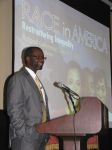In New York City, the Harlem Children’s Zone, a nonprofit organization, has been working to break the cycle of poverty one family at a time. With parenting workshops, a pre-school program, three public charter schools and child-oriented health programs, the organization has helped approximately 17,000 children.
Recently, President Barack Obama’s administration announced it would launch the 20 Promise Neighborhoods program, which hopes to replicate the success of the HCZ in poverty-stricken areas of other U.S. cities.
 |
| HOMEWOOD CHILDREN’S VILLAGE—John Wallace gives a presentation during the conference session “Refocus and Reform: Changing Direction in Urban Schools.”
|
However, for the past two years, John Wallace, Ph.D., a University of Pittsburgh professor, has led an effort to bring HCZ to Pittsburgh. On June 23, the plan moved one step closer to reality when the Pittsburgh Public School District Board voted to add support services to Westinghouse High School, a key component of the Homewood Children’s Village proposal.
At the Race in America Conference June 5, Wallace presented his plans for the Homewood Children’s Village and highlighted the strengths and shortcomings of the Homewood community whose schools would be utilized.
“Homewood has significant assets,” Wallace said. “By high school one percent of the kids at Westinghouse High School were proficient at reading. Forty-six percent of kids at Westinghouse are Promise ready.”
The Pittsburgh Promise is a program that gives PPS students $20,000 for college if they meet certain requirements. By factoring in the monetary value of each Pittsburgh Promise scholarship, Wallace discovered that an estimated $20,347,200 is being unclaimed by Homewood students.
“The greatest investment we can do is get young African-American men to and through high school and college,” Wallace said. “The reality is investing in these young people returns some to society. One way or another we’re going to pay for these young people. Pay now or pay later.”
In order to ensure students achieve in the classroom, Wallace and a number of other experts said schools must address the socioeconomic shortcomings in neighborhood families. Students in Homewood are not only behind in the classroom but also in necessities such as health care.
“Five percent of White students attend schools where 76 to 100 percent of students receive free or reduced lunch. The issue with education, this relationship with income is the problem,” Wallace said. “We have to build full service schools. The fact that we don’t take into account that the majority of the students in these schools are poor, that’s a problem.”
Wallace said full service schools can have an immediate impact on the entire community including parents and those no longer in school. By helping the entire community, the streets can become safer and lead to a better learning environment for students.
“If the perception of the community is the way it is, what we do in schools doesn’t matter,” Wallace said. “When you sit down in the seat and someone just got shot last night, you don’t really feel like diagramming sentences.”